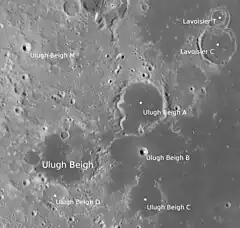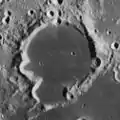Ulugh Beigh (crater)
Ulugh Beigh is the remnant of a lunar impact crater that is located just to the west of the Oceanus Procellarum. It is located near the northwestern limb of the Moon, and from the Earth it appears foreshortened. Farther to the west is the smaller crater Aston, and to the north is Lavoisier. Both these craters are roughly equidistant from Ulugh Beigh, although Aston appears much closer due to the oblique viewing angle.
 Lunar Orbiter 4 image | |
| Coordinates | 32.7°N 81.9°W |
|---|---|
| Diameter | 54 km |
| Depth | 1.7 km |
| Colongitude | 83° at sunrise |
| Eponym | Ulugh Beg |

The rim of this crater has been nearly worn away by impacts, leaving a disintegrated perimeter that is notched and incised by impacts. Ulugh Beigh D lies across the southern part of the floor, and a smaller crater along the western rim shares a common floor with Ulugh Beigh. The interior floor of this crater has been resurfaced by lava, leaving a dark surface with the same albedo as the neighboring mare. The northern part of the crater has a higher albedo than this dark surface, matching the appearance of the terrain to the west of the mare.
Ulugh Beigh A is located to the northeast of the main crater, and forms a flooded crater along the edge of the Oceanus Procellarum. This is a merged formation with a smaller crater lying across the southwest rim of the larger, and the two sharing a common dark floor.
This formation is named after the Timurid king and science patron Mīrzā Muhammad bin Shāhrukh, popularly known as Uluğ Bey (Chaghatai: great king), who supported the work of several well-known astronomers.
Satellite craters
By convention, these features are identified on lunar maps by placing the letter on the side of the crater midpoint that is closest to Ulugh Beigh.
| Ulugh Beigh | Latitude | Longitude | Diameter |
|---|---|---|---|
| A | 34.1° N | 79.3° W | 41 km |
| B | 32.8° N | 79.3° W | 8 km |
| C | 31.4° N | 79.1° W | 31 km |
| D | 31.6° N | 82.4° W | 21 km |
| M | 35.7° N | 83.4° W | 7 km |
 Ulugh Beigh A
Ulugh Beigh A
Notes
References
- Andersson, L. E.; Whitaker, E. A. (1982). NASA Catalogue of Lunar Nomenclature. NASA RP-1097.
- Blue, Jennifer (July 25, 2007). "Gazetteer of Planetary Nomenclature". USGS. Retrieved 2007-08-05.
- Bussey, B.; Spudis, P. (2004). The Clementine Atlas of the Moon. New York: Cambridge University Press. ISBN 978-0-521-81528-4.
- Cocks, Elijah E.; Cocks, Josiah C. (1995). Who's Who on the Moon: A Biographical Dictionary of Lunar Nomenclature. Tudor Publishers. ISBN 978-0-936389-27-1.
- McDowell, Jonathan (July 15, 2007). "Lunar Nomenclature". Jonathan's Space Report. Retrieved 2007-10-24.
- Menzel, D. H.; Minnaert, M.; Levin, B.; Dollfus, A.; Bell, B. (1971). "Report on Lunar Nomenclature by the Working Group of Commission 17 of the IAU". Space Science Reviews. 12 (2): 136–186. Bibcode:1971SSRv...12..136M. doi:10.1007/BF00171763. S2CID 122125855.
- Moore, Patrick (2001). On the Moon. Sterling Publishing Co. ISBN 978-0-304-35469-6.
- Price, Fred W. (1988). The Moon Observer's Handbook. Cambridge University Press. ISBN 978-0-521-33500-3.
- Rükl, Antonín (1990). Atlas of the Moon. Kalmbach Books. ISBN 978-0-913135-17-4.
- Webb, Rev. T. W. (1962). Celestial Objects for Common Telescopes (6th revised ed.). Dover. ISBN 978-0-486-20917-3.
- Whitaker, Ewen A. (1999). Mapping and Naming the Moon. Cambridge University Press. ISBN 978-0-521-62248-6.
- Wlasuk, Peter T. (2000). Observing the Moon. Springer. ISBN 978-1-85233-193-1.